Impression
The Chaintech VNF4 Ultra is built upon a black PCB with black, blue and tan connectors, nothing fancy, nothing colorful, except for the huge green and purple capacitors. While a regular ATX board, the VNF4 is smaller than most, so fitting it into a smaller case shouldn't pose much of an issue.

As soon as I saw this board I knew that it was not going to be a great overclocker. First, while Chaintech had the right idea moving the memory slots horizontally above the processor, they made two mistakes (In my opinion). Chaintech decided to pair the memory slots in an unorthidox configuration. Where most boards require you to use slots 1 and 3 or 2 and 4 for dual channel performance, Chaintech recommends you use only slots 1 and 2! They recommend against you using any other configuration, including the use of all four memory slots.
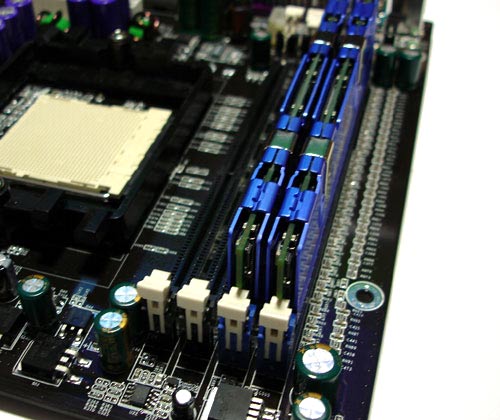
The second issue here is the spacing between these slots....as in there isn't any. So while they had the right idea in placing the memory horizontal for cooling, the actual execution here was flawed in that the memory slots were placed too close together to actually do any good.

Next week when I bring you the latest and greatest board from DFI, I'll show you the importance of good cooling when it comes to the chipset. Needless to say, active cooling is going to be a must on these nForce 4 boards as they run red hot. Chaintech is the first board I've seen to use a simple passive cooling solution, and to be honest, I really see this holding the board back from any type of overclocking. While running the board at stock settings during benchmarking, the chipset cooler was extremely hot to the touch.

The last issue I want to touch on is the area surrounding the CPU socket. It looks like Chaintech used capacitors that have been abusing steroids, as these guys are monsters. Unfortunately I didn't have access to any large cooling solutions, but I'm guessing this board would have a hard time with the likes of a Thermalright XP-120 or a Zalman CPNS-7700. So beware when making a HSF selection.
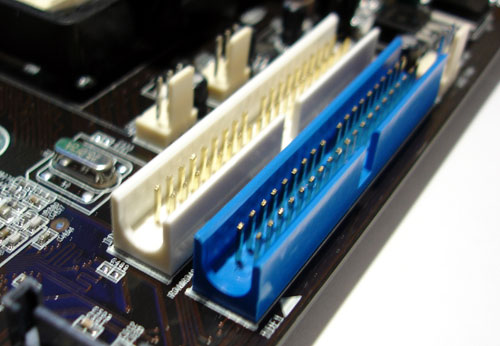
Moving on to the boards connectors, I was a tad concerned by how Chaintech implemented the IDE connectors. While the placement is fine, Chaintech left each end of the IDE connectors open. This could be a problem if you can't see what you are doing or line up an IDE or FDD cable wrong.
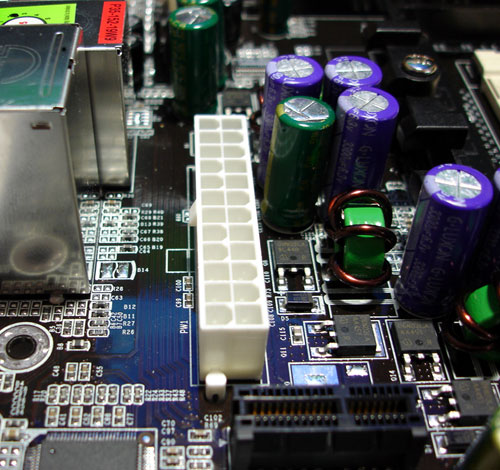
Moving on the 4 pin ATX power connector and the 24 pin power connector, Chaintech chose an interesting location on the left side of the board behind the I/O ports. This might present a problem depending on your case and fan arrangement. I thought it would, but for me it actually worked out very nicely as the power cable tucked neatly under the fan housing.

Other than the issues I've touched on, the VNF 4 Ultra has a clean and very simple layout, with 4 fan connectors (oddly, one is labeled "chip fan" yet Chaintech used passive cooling), two IDE connectors (A nice touch considering most board makers have cut back to a single IDE connector), two PCI-E x1, a single PCI-E x16, and three PCI 2.1 slots.
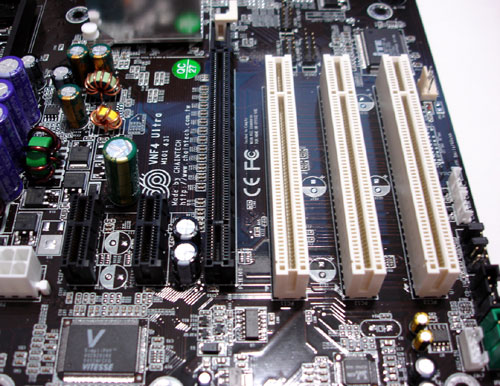

Chaintech chose the popular Gigabit network connection for the VNF 4 Ultra network solution. Most people prefer this over Realteks LAN solution, but I really can tell no difference in performance between the two. A nice feature is nVidia's Active Armor, which is an integrated hardware protection system that includes nVidia's firewall 2.0 utility. I really like this as alot of people just don't realize how important a firewall is until its too late. By actually including one in the package, Chaintech removes all your excuses, so when disaster strikes, you have no one to blame but yourself.

For the integrated audio, Chaintech chose the AC?7 Realtek ALC850 codec that works with NVIDIA?s own driver and nvMixer utility. Not many enthusiasts are using onboard sound so this really isn't an issue, but I would really like to see some of these board companies follow MSI's lead and use something special like Creative's integrated Audigy chip, or even something comparable to Intel's HD Audio. Sometimes, even when building a budget alternative, people appreciate little things like this that might mean $20-25 more in board cost, but will save them $80 to 100 in overall system cost.
When it came to storage, chaintech supllies what has really become the standard fare. Besides the two IDE connections and FDD connection, the VNF4 also comes equipped with 4 SATA connections which support SATA 2 at 300MB/s in RAID 0, RAID 1, and RAID 0+1. One thing it doesn't support is the newest form RAID 5.

As to the rear I/O port, the VNF4 comes with a very basic array, one thing noticably missing is any optical or difital audio output, disappointing, but I addressed the sound issue earlier, most people will bypass the onboard audio for a better solution.
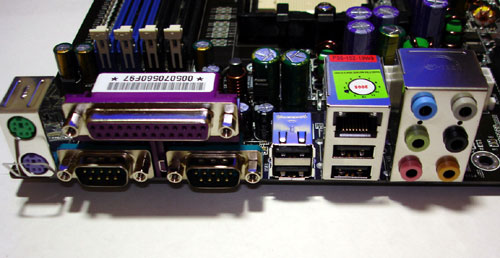
As far as the included bundle, I really liked the software bundle Chaintech included. Getting Norton Anti-Virus ($50 if you were to buy it alone), coupled with nVidia's Firewall program, provides you with a good 1-2 punch when it comes to internet security, all that you really need to top that off is a good spyware app or two (might I suggest Adaware Personal Edition and SpywareBlaster?).


 Chaintech Adds Robustness to nForce4 Ultra Products (2005-02-08)
Chaintech Adds Robustness to nForce4 Ultra Products (2005-02-08) Chaintech Zenith V915P Review (2005-02-02)
Chaintech Zenith V915P Review (2005-02-02) Chaintech GeForce 6600 GT AGP Review (2004-12-26)
Chaintech GeForce 6600 GT AGP Review (2004-12-26) 













